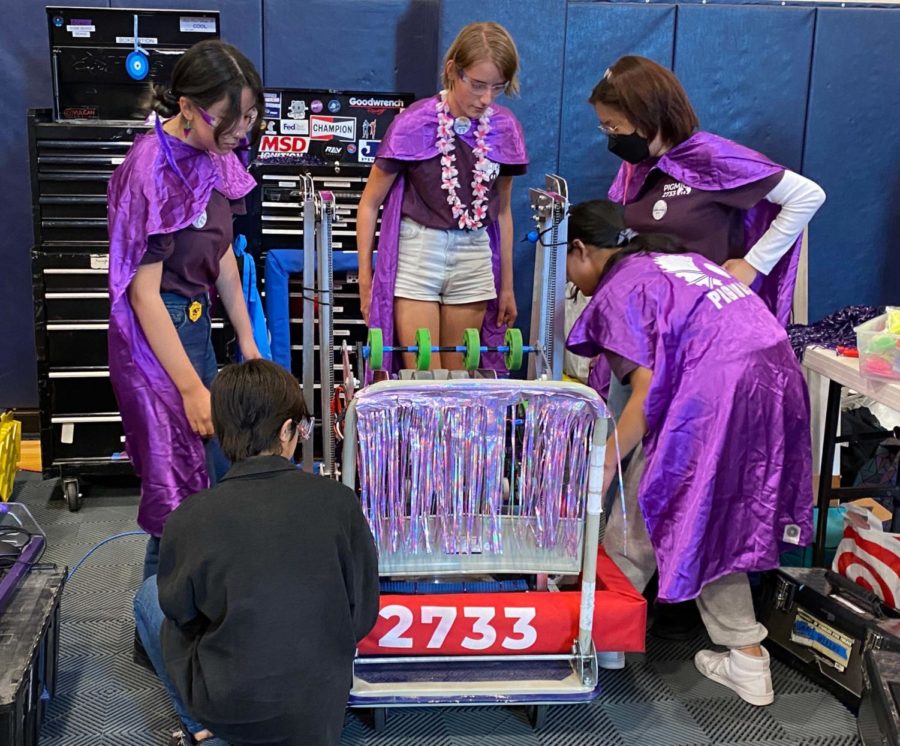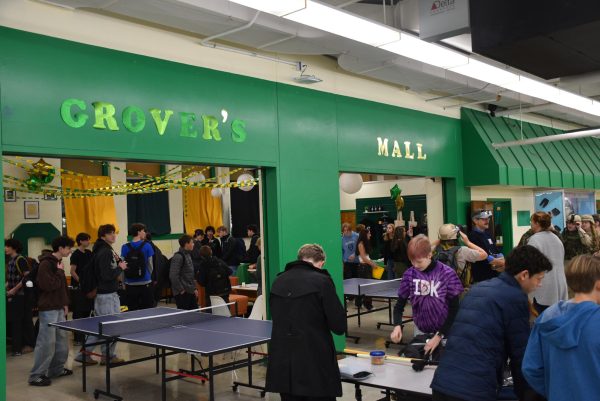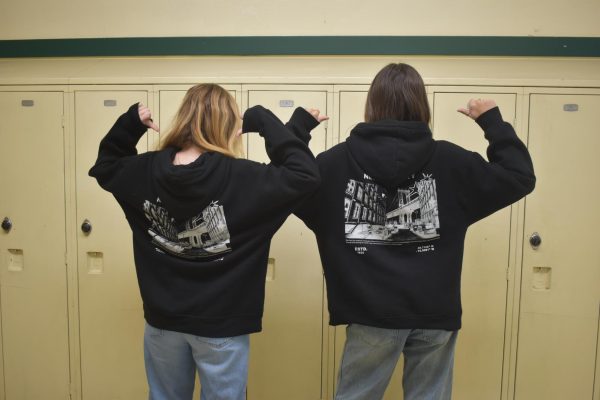Girls Take Control at Robotics Event
Girls Gen event ignites interest in STEM
A vivacious school gym packed with energetic girls from different places, cheering and celebrating each other. You’ll see that scene at the Girls Generation robotic competition this year. Females control robots to do amazing movements and play intense games, proving to the world that women can be successful in the STEM field just like men.
Sponsored by FIRST Robotic Competition(FRC), Girls Generation is advertised as a competition “open to robotic team members that identify as female or non-binary, the goal is to give underrepresented people the chance to step forward and control the robot.” This competition plays the game from the previous year’s FRC competition, using every team’s same robot, but only girls are playing the games and boys would be on the side cheering for them.
2022’s Girls Gen was hosted at Wilsonville High School Oct. 15 for high school robotics teams in Oregon and southeast Washington. Pigmice, the Cleveland high school robotics team, competed with their robot “Teapot.” This year, many new female members joined the team. Since the robot was already built and tested, it’s an easy start for new members because the task is mainly to control the robot. It’s an opportunity for them to learn and practice with a lot of support.
On the day of the competition, from 7:30 a.m. to 5:30 p.m. on Oct. 15, only girls are allowed to touch the robot. They get to do everything, including repairing broken parts, moving the robot in and out of the pit, and controlling the robot to play games and compete. Male members are only allowed to stand by and give any support the girls need.
In total, 15 teams attended Girls Gen, and each team had about 30 people. After they arrived, they each set up the little pit area and made a workshop. Many of them were well-decorated and the whole pit looked pretty. Team members visited with each other and handed out their pins or stickers, and exchanged information about each other’s team.
Every girl was super supportive, cheering with their loudest voice and helping other teams fix their robot when accidents happened. It was a very inclusive and welcoming environment, and everyone tried their best to make it a good time for all participants and guide those who are new to FRC.
“It was really fun! I got to learn a lot and the most fun experience was driving the robot, ‘cause it was very interesting, seeing how the controls work and how they’re programmed to connect the robot and make it move in an impressive way,” said a junior female Pigmice member who was a driver of the robot during Girls Gen.
In the end, Pigmice made it to the semi-finals but lost with a very close score. It is not the best the robot can do because some wires and bearings were damaged during the competition, but every player tried their best to go with what they had. The rest of the team was also supportive. Male members kept helping to come up with new strategies and advice, and they were happy that “Teapot” had another chance to play well on the field.
All the female members of the team who were there claimed that it was an exhausting day because they only had eight girls, which was a lot fewer compared to other teams that had at least 10, but none of them regret participating because they had an amazing experience and got to learn a lot that they don’t usually have the chance to know.
“I feel like I belong more with girls, and I don’t feel like I’m being left out,” the driver mentioned.
This brings up the problem that, because there are a lot of guys already on the team, when new members who identify as women join, with the stereotype of “women don’t do STEM,” and the awkwardness of the big gap between the number of male and female in the team, they feel miserable and don’t know what to do, adding firewood to an unwelcoming environment for women and causing them to give up on the STEM field.
The female driver said, “Women don’t really get into contact … . These robotics kinds of stuff are considered not girly, so a lot of girls would rather do more girly stuff. Because a lot of people have a biased point of view, like ‘Yo, men should like this specific stuff, women should like this stuff.’ So they’re just gonna tell this to this person because of their gender.”
Stereotypes between men and women have been continuing for decades. In the long history, when women try jobs that are mostly done by men, they get denied, overpowered, and men even steal their work and do not give credit to them. Many teachers or parents from the older generation would assign specific hobbies to different genders, and introduce certain things to one gender more than the other, which is one of the factors causing this highly unbalanced number of males and females.
The stereotype made it hard for girls who want to break this invisible barrier and step into that middle zone where one group participates more than the other. Not just because they feel awkward being the “odd” one, but also because guys are not used to it either. Many tiny elements add up and make them feel welcomed and not needed.
This reporter was Pigmice’s operator of the robot in Girls Gen. When she first joined the club, there were almost 20 men in the room with only a few females. It was terrifying to be in a room packed with so many people with the same identity that is different from yours because it’s hard to feel secure and belong. Sometimes it can be really hard to fit into a big group of another gender, so when female members joined, many of them just stood by the side not knowing what to do.
But Girls Gen allowed them to be involved in the club more. The whole team would help them to prepare for the competition and teach them more hardcore information, and it helped them to feel valued and included. The competition had a really nice vibe because all the girls were supporting and cheering for the other teams. They didn’t judge women, they complimented and encouraged each other, showing kindness and willingness to involve more girls in STEM. This event surely gave them lots of the confidence and support they needed.
Girls from many teams all have the same thought that working with only females feels comfortable because they’re all the same, and would continue attending these types of events because it helped them to learn how fun robotics can be.
Bianca Ma from St. Mary’s Academy, a private all-girls high school in Portland, also said, “I feel more open about sharing ideas,” when being asked about how it feels like having classes with only girls. “Personally it’s more of a comfortable environment for me, the vibe is totally different … . The girls are way more patient and understanding,” she said.
Rafael Bobenrieth, a Cleveland physics teacher who’s been teaching here for six years, also has opinions about this event.
“The year I got here, the statistics for the highest level of the IB physics at CHS, the female representation was 20 percent. In other words, if I looked at my class of 35 students, there were maybe six females in them. And so I embarked on doing a lot of different things. And I’ve had some success, like I’ve been able to get it up as high as almost 40 percent,” he said.
According to https://onlinedegrees.und.edu/, in 1970, women represented 38 percent of all U.S. workers, but only 8 percent of STEM workers. Now In 2019, women represented 48 percent of all U.S. workers and 27 percent of STEM workers, still not much but slowly increasing. This is a topic Bobenrieth spent a lot of time thinking about. He’s been trying to make adjustments to improve the representation of certain groups that are participating in science.
He talked about the idea of microaggressions, these little interactions that happen daily that might be unnoticed, but hurt the person who is the recipient of the microaggression. Over time, the cumulative effect of all these microaggressions can make them feel like this is a place or setting where they don’t fit in, they’re not welcomed. It decreases their interest and passion to participate in whatever they’re doing, and also plays a huge role in the reason why STEM is mainly one certain group of people. So over the past few years, he’s been setting up activities for students to acknowledge and identify microaggression and implicit bias.
Bobenrieth said, “I know that happens in science classes. I know what happens in my class. In fact, I’ve had students come talk to me after the fact about what happened to them. What I think is one of the most important things that I can try and do as a teacher is to make sure that my environment and the overall building environment is one that is welcoming, help everyone, including those groups, feel like they are welcome, and that they can do this stuff because they can and that they are needed, and that we want them to pursue these fields.”
He agreed that Girls Gen is one great solution to invite more underrepresented groups into STEM because he has experienced that putting girls together helps them learn better.
“I think there needs to be space created for whatever the underrepresented group is – women, African Americans, whoever, whatever the case may be. I think it’s really important. There’ll be spaces created, where those students can really work with just their group,” Bobenrieth said.
“If I see there’s a group of females who really want to sit with each other, I’ll often put them together. And I have found over time, that can be quite powerful and successful, because the quality of conversations they have, the level of comfort they have and sharing their ideas, their doubts about whatever they’re studying, tends to be higher. When they feel like they’re in a safe space and a safe space is more often than not one where they are surrounded with people from their same sort of underrepresented group. So I think those are tremendously valuable. And they have to continue. Obviously, just having those and doing nothing else won’t solve the problem. But I think those are really great ways to attack the problem,” Bobenrieth said.
Girls Gen was a great time for everyone. It was a nice, safe space for women and non-binary people to not get judged by men and biases, encouraging them to pursue what they like. In the future, there should be more events like this, because there is still a need to increase the underrepresented groups in STEM fields until every type of person is treated equally. Girls Generation is a start, but it will not be the last thing to do.












